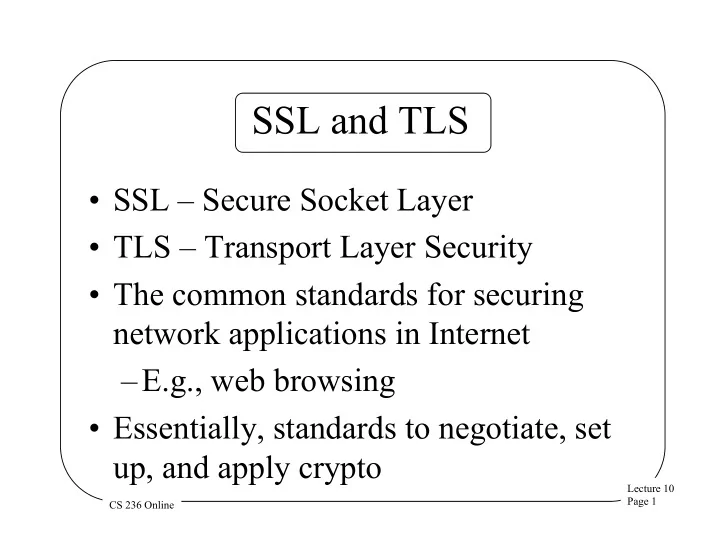

SSL and TLS • SSL – Secure Socket Layer • TLS – Transport Layer Security • The common standards for securing network applications in Internet – E.g., web browsing • Essentially, standards to negotiate, set up, and apply crypto Lecture 10 Page 1 CS 236 Online
The Basics of SSL • Usually a client/server operation • Client contacts server • A negotiation over authentication, key exchange, and cipher takes place • Authentication is performed and key agreed upon • Then all packets are encrypted with that key and cipher at application level Lecture 10 Page 2 CS 236 Online
Common Use • Server authenticates to client using an X.509 certificate – Typically, client not authenticated • Though option allows it • Client provides material to server to derive session key • Client and server derive same session key, start sending encrypted packets Lecture 10 Page 3 CS 236 Online
Crypto in TLS/SSL • Several options supported • RSA or elliptic curve for PK part • AES, DES, 3DES, or others for session cryptography • Not all are regarded as still secure • Chosen by negotiation between client and server Lecture 10 Page 4 CS 236 Online
Use of SSL/TLS • The core crypto for web traffic • Commonly used for many other encrypted communications • Used in all major browsers • Usually not part of OS per se – But all major OSes include libraries or packages that implement it Lecture 10 Page 5 CS 236 Online
Security Status of SSL/TLS • Kind of complex • SSL is not very secure • Early versions of TLS not so secure • Later versions of TLS fairly secure – Depending on cipher choice • Recent chosen-plaintext attacks shown to work on all versions – In special circumstances Lecture 10 Page 6 CS 236 Online
Virtual Private Networks • VPNs • What if your company has more than one office? • And they’re far apart? – Like on opposite coasts of the US • How can you have secure cooperation between them? • Could use leased lines, but . . . Lecture 10 Page 7 CS 236 Online
Encryption and Virtual Private Networks • Use encryption to convert a shared line to a “private line” • Set up a firewall at each installation’s network • Set up shared encryption keys between the firewalls • Encrypt all traffic using those keys Lecture 10 Page 8 CS 236 Online
Actual Use of Encryption in VPNs • VPNs run over the Internet • Internet routers can’t handle fully encrypted packets • Obviously, VPN packets aren’t entirely encrypted • They are encrypted in a tunnel mode – Often using IPSec • Gives owners flexibility and control Lecture 10 Page 9 CS 236 Online
Key Management and VPNs • All security of the VPN relies on key secrecy • How do you communicate the key? – In early implementations, manually – Modern VPNs use IKE or proprietary key servers • How often do you change the key? – IKE allows frequent changes Lecture 10 Page 10 CS 236 Online
VPNs and Firewalls • VPN encryption is typically done between firewall machines – VPN often integrated into firewall product • Do I need the firewall for anything else? • Probably, since I still need to allow non-VPN traffic in and out • Need firewall “inside” VPN – Since VPN traffic encrypted – Including stuff like IP addresses and ports – “Inside” can mean “later in same box” Lecture 10 Page 11 CS 236 Online
VPNs and Portable Computing • Increasingly, workers connect to offices remotely – While on travel – Or when working from home • VPNs offer a secure solution – Typically as software in the portable computer • Usually needs to be pre-configured Lecture 10 Page 12 CS 236 Online
VPN Deployment Issues • Desirable not to have to pre-deploy VPN software – Clients get access from any machine • Possible by using downloaded code – Connect to server, download VPN applet, away you go – Often done via web browser – Leveraging existing SSL code – Authentication via user ID/password – Implies you trust the applet . . . • Issue of compromised user machine Lecture 10 Page 13 CS 236 Online
Recommend
More recommend